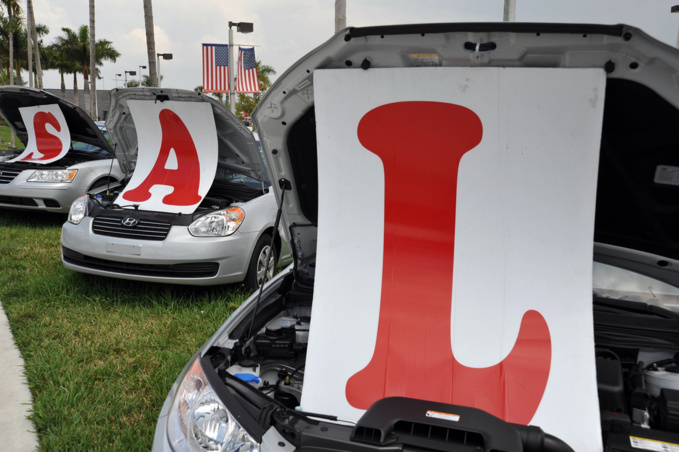Analysts, quoted by the Financial Times newspaper, believe that banks are simply afraid to repeat the mistakes they made during the mortgage crisis. Recall that the so-called housing bubble was caused by a sharp increase in non-payments on mortgage loans and ignited the financial crisis of 2007-2008. For example, one of the largest players in the car loan market in the US, Wells Fargo, reduced the issuance of new car loans by 29%in the first quarter, compared with the same period last year. This is the largest reduction of the corresponding indicator for five years. Other credit and financial institutions operate in the same vein, including JPMorgan Chase, Ally Financial, Santander Consumer USA Holdings, Capital One.
Experts explain this by lowering prices for used cars. The reduction was 8% since January. Against this background, the number of cases of non-return of auto loans is growing, since consumers are often unable to repay a loan, amount of which exceeds the cost of the car.
Over the past two years, US residents with low credit ratings have taken car loans worth $ 244 billion, which became the highest rate since 2006-2007.
"This figure is worrying. It is big enough to provoke conversations about a "bubble", notes Bloomberg. The problem is that many of these drivers have bad credit ratings - it means that they most likely violated terms of loan agreements earlier.
According to the agency, the amount of arrears on auto loans is equal to the price for 43.4 million pickups Ford F-150. Statistically, every citizen of the United States with the rights to drive owe about $ 6.1 thousand in auto loans.
The problem of the growing "bad" car loans would hit the market of debt securities secured by high-risk auto loans, the Financial Times reported in November. According to the Association of Securities and Financial Markets, the volume of this market in November was about $ 38.1 billion, which is 7.5% lower than in the second quarter of 2016.
Losses in the market can provoke a decrease in investor confidence in this instrument. Reducing the demand for such bonds may put issuers on the brink of creditworthiness. "There are all ingredients for a crisis. Especially the increase in losses - this can become a catalyst. We believe that the risks are growing", said Peter McNally, a representative of Moody's rating agency.
Average loan amount for a new car in the US reached a historic high of $ 30.621 thousand in the fourth quarter of 2016, according to Experian consulting company.
The average loan amount for a used car also broke the record, rising to $ 19,329 thousand compared to $ 18,850 in the fourth quarter of 2015. At the same time, the share of auto loans for a long period (from 73 to 84 months) for new cars increased in October-December to 32.1% against 29% for the same period a year earlier.
source: ft.com, bloomberg.com
Experts explain this by lowering prices for used cars. The reduction was 8% since January. Against this background, the number of cases of non-return of auto loans is growing, since consumers are often unable to repay a loan, amount of which exceeds the cost of the car.
Over the past two years, US residents with low credit ratings have taken car loans worth $ 244 billion, which became the highest rate since 2006-2007.
"This figure is worrying. It is big enough to provoke conversations about a "bubble", notes Bloomberg. The problem is that many of these drivers have bad credit ratings - it means that they most likely violated terms of loan agreements earlier.
According to the agency, the amount of arrears on auto loans is equal to the price for 43.4 million pickups Ford F-150. Statistically, every citizen of the United States with the rights to drive owe about $ 6.1 thousand in auto loans.
The problem of the growing "bad" car loans would hit the market of debt securities secured by high-risk auto loans, the Financial Times reported in November. According to the Association of Securities and Financial Markets, the volume of this market in November was about $ 38.1 billion, which is 7.5% lower than in the second quarter of 2016.
Losses in the market can provoke a decrease in investor confidence in this instrument. Reducing the demand for such bonds may put issuers on the brink of creditworthiness. "There are all ingredients for a crisis. Especially the increase in losses - this can become a catalyst. We believe that the risks are growing", said Peter McNally, a representative of Moody's rating agency.
Average loan amount for a new car in the US reached a historic high of $ 30.621 thousand in the fourth quarter of 2016, according to Experian consulting company.
The average loan amount for a used car also broke the record, rising to $ 19,329 thousand compared to $ 18,850 in the fourth quarter of 2015. At the same time, the share of auto loans for a long period (from 73 to 84 months) for new cars increased in October-December to 32.1% against 29% for the same period a year earlier.
source: ft.com, bloomberg.com


















